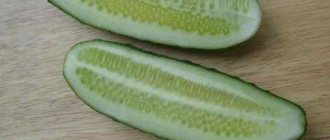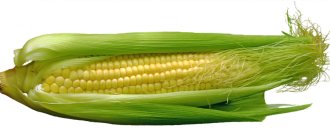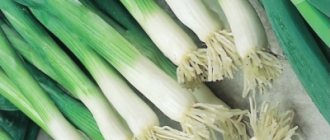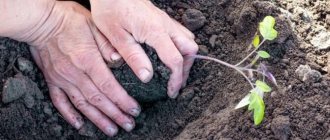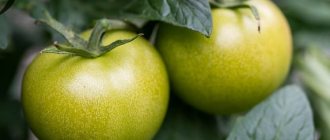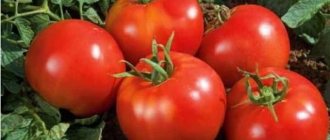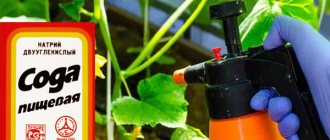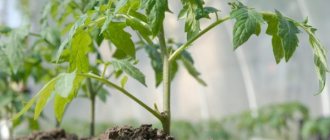What determines tomato yield?
A good tomato harvest depends on many factors.
The most important thing is choosing the right variety. To get a large number of fruits, you need to choose high-yielding varieties. These are usually late-ripening, tall varieties. Although some low-growing varieties can also show good yield.
The second important point is the choice of time for planting in open ground. If you plant seedlings ahead of time, the seedlings may freeze due to return frosts and sudden cold snaps.
The third thing you should take care of in order to get a good tomato harvest in open ground is to provide the plantings with proper care. It is necessary to establish an irrigation and fertilizing regime, to hill up and plant the tomatoes on time.
Also, do not forget about treatment against pests and diseases, since the negative effects of parasites and pathogenic microflora will cause tomatoes to become sick and significantly reduce their yield.
Pests and diseases of tomatoes and their protection
When growing tomatoes, fungal diseases and pests can cause great harm, which undoubtedly reduces the yield.
Fungal diseases are late blight (gray spots appear on the fruits), blackleg (the stem dries out at the root) and many others.
Ways to combat them are disinfection of the soil in the fall, compliance with crop rotation, treatment of seedlings (spray with Bordeaux mixture 5 days before planting in the ground), disinfection of the soil before planting and treatment with fungicides or removal of diseased plants. It is advisable not to over-moisten the soil under the tomatoes and ventilate more often (they love this).
Well-known pests of tomatoes are wireworms and mole crickets (damage the roots), whitefly, potato flea beetle (damage the tops).
If they have reached the plant, then it is necessary to apply chemicals (once every 2 weeks) - insecticides and acaricides. Just remember that they are toxic and when the fruits are already ripe, it is better not to use them. At this time, you can use biological products (Fitoverm, etc.) And there are also traditional methods of struggle. Infusion of onion peel, celandine - try it!
How to choose the right variety to get a large harvest of tomatoes in open ground
So, good productivity of tomatoes in open ground, first of all, depends on the choice of a suitable variety.
You need to choose which tomatoes to plant on your site depending on the following factors:
- growing region;
- soil type;
- possibility of regular care.
When buying tomato seeds for planting, it is very important to select zoned varieties, that is, those that are suitable for growing in your region.
The fact is that in the northern regions of Russia, summer is short and often cold, so late varieties with a ripening period of 120 - 140 days simply do not have time to ripen in open ground.
Therefore, early ripening varieties and hybrids are chosen for the Urals and Siberia (for example, Pink Honey, Caspar F1, Goldfish, Summer Resident, Mongolian Dwarf, Sanka, Velmozha , etc.).
Next, you need to evaluate the growing conditions. If your site has poor soil, then it is better to choose more resistant and unpretentious varieties.
The same goes for leaving. If you do not have the opportunity to plant and tie tomatoes, then it is better to plant low-growing varieties that do not require all this.
How to properly grow tomatoes from seed to harvest
There is probably no amateur vegetable grower who does not grow tomatoes on his plot. According to statistics, tomatoes take second place in popularity among vegetables, second only to the traditionally leading cucumber.
This popularity is understandable, because ripe, aromatic tomatoes are distinguished not only by their excellent taste, but also by their high content of vitamins and nutrients.
The fruit pulp contains all B vitamins, vitamins A, C, D, E, K, PP, beta-carotene; microelements – magnesium, potassium, manganese, phosphorus, calcium, chromium, iron, copper, zinc, selenium; complex organic acids, pectins, various sugars and natural antibiotics and the most powerful antioxidant lycopene. Therefore, tomatoes are incredibly healthy.
These heat-loving “sissies” come from South America and today feel great in the greenhouses of Russian gardeners. And some frost-resistant modern varieties and hybrids give good yields in open ground.
But there are a number of features, without knowledge of which growing tomatoes will be quite difficult. This is what we want to talk about in this article.
HOW TO GROW GOOD TOMATO SEEDLINGS
The quality of seedlings is primarily determined by the timing of seed sowing. And here it is important not to rush. Some experts recommend performing this operation as early as the end of February. But at this time the daylight hours are too short, and the plants will need additional lighting. In such conditions, seedlings turn out to be too elongated and pale.
It's better to wait a little, and the results will be completely different. Optimal sowing dates: for greenhouses and greenhouses - March 16 - 21; for open ground – April 2 – 9.
Temperature is of great importance for seedlings. After sowing, the boxes with seedlings are covered with film and placed in a room with a temperature of + 25 degrees. When the first green shoots appear, the seedlings are placed on the window and the room temperature is reduced to 17 degrees during the day and 12 at night.
An important operation when growing tomatoes is picking young plants into separate cups. It is carried out two weeks after emergence. The room temperature is raised to + 22 degrees during the day and 16 degrees at night.
The air humidity in the room when growing tomato seedlings should be 65 percent. Watering is carried out as the soil dries out (but not less than once every two days). At the same time, you need to constantly ensure that the soil in the pot does not become waterlogged, otherwise the roots may rot.
Plants are fed approximately once every two weeks. To do this, use a liquid solution of some mineral fertilizer for tomato seedlings.
10 days before planting tomatoes in a greenhouse or greenhouse, trays with seedlings are placed on a balcony or loggia during the day for several hours. This will help the plants get stronger and make it easier to transplant.
As practice shows, the “age” of tomato seedlings should be: for early ripening varieties – 52 days; for later – 62 days.
SOME SUBTLES OF GROWING TOMATOES IN A GREENHOUSE
It is not recommended to grow tomatoes in the same greenhouse as cucumbers, because they need completely different conditions. Cucumbers require high humidity (more than 85%) and high temperatures (+30 - 35 degrees).
And in tomatoes, at a temperature of +34 degrees, pollination stops, as the pollen becomes viscous. And the humidity in the room should not exceed 65%, otherwise the plants may get late blight.
If you still have to grow these two crops in a large greenhouse, a “curtain” of double film is made in the middle, which will help soften the coexistence of cucumbers and tomatoes.
Sometimes tomatoes suddenly begin to grow wildly with powerful green leaves to the detriment of flowering and fruiting. This indicates that the plants are overfed with nitrogen. It should be excluded from the fertilizer composition and only phosphorus-potassium nutrition should be given.
During hot weather, the temperature in the greenhouse can become very high. In addition, humid air will constantly stagnate in a closed room. Both can lead to disease and even plant death. Therefore, tomatoes need constant drafts. In summer, the doors to the greenhouse are left open not only during the day, but also at night.
Both tall and short tomato plants literally “bend” under the weight of the harvest. Therefore, they definitely need supports. The garter must be done no later than 4 days after transplantation.
A wire trellis is stretched under the ceiling of the greenhouse above the plants. A rope is attached to each bush under the lower leaves with a loop, the upper end of which is loosely tied to the twine, leaving about a meter. This is necessary to lengthen the rope, wrapping it around the bush as it grows.
An important technique for tall varieties is the removal of side shoots (pinching) as the bush grows and its formation into one stem. After the fruits appear on the lower clusters, all the leaves under them begin to be removed. Exactly the same - under the next brushes. The result is a bare trunk, all strewn with tomatoes.
When the bush grows to the top of the greenhouse, it is simply broken off, leaving three leaves for nutrition. Low-growing varieties do not take stepson. They themselves form a bush 60–90 centimeters high. For better pollination, it is recommended to lightly shake the plants in the morning.
CHOOSE VARIETIES TO GROW THE BEST TOMATOES
Our company has been engaged in variety testing and selection of almost all types of tomatoes for more than twenty years. There are so many of them that it is difficult for a novice vegetable grower to navigate this abundance.
When choosing varieties, you must decide for yourself what kind of tomatoes you want to get, and first of all, by taste, ripening time, size and color. You need to determine where you will grow them: in a greenhouse, greenhouse or open ground. When you understand what you want, you can choose varieties.
Our company offers varieties and hybrids of tomatoes for greenhouses, film shelters and open ground. We have hybrids and varieties that are especially sweet, unique pepper-shaped, with a high content of lycopene, extra large-fruited, and productive cherry. Among them are fruits of all shades: pink, red, burgundy, orange, yellow, chocolate. This year we are offering a lot of new products.
All our tomatoes are very tasty, aromatic, and have increased resistance to fungal diseases. Try growing these tomatoes in your garden - you won’t regret it!
How to prepare tomato seedlings for growing in open ground?
The success of growing and whether you get a good harvest or not depends on how well the seedlings are ready for transplanting.
By the time of planting in open ground, seedlings should be 2 - 2.5 months old, have several pairs of true leaves, be plump and strong.
It is advisable to plant the seedlings in separate containers to make replanting more convenient (this will prevent the roots from getting tangled).
At the stage of growing seedlings, tomatoes are fed twice. In this case, growth regulators and liquid fertilizers based on humate are mainly used.
Somewhere 7-10 days before transplanting to a permanent place in the open ground, tomatoes should begin to harden. To do this, seedlings begin to gradually become accustomed to outdoor conditions. First, the tomatoes are taken out into the open air for 30 - 40 minutes. Then for a few hours. And so on until the seedlings have been outside the house all day.
ON A NOTE. Hardening is not a mandatory procedure, but it allows you to prepare tomato seedlings for new growth conditions, which will have a beneficial effect on its growth, since the seedlings will experience less stress.
What soil is suitable for growing tomato seedlings
Tomato seedlings are undemanding to the soil - relatively resistant to drought, not gluttonous, and tolerate slightly increased acidity. It grows well in soil prepared with your own hands (with the addition of loam, humus and compost). And also in purchased peat soil - if only it is a bona fide product (high-moor, deoxidized peat, filled with fertilizers). It is believed that soil prepared by hand needs to be steamed, but purchased soil is not necessary. This is correct, but only on condition that you perfectly follow the technology for growing tomato seedlings: temperature, lighting, feeding. In fact, this condition is almost impossible to fulfill: seedlings at home are highly susceptible to stress and vulnerable even to fairly harmless fungi. Therefore, it is better to steam all the soil, regardless of origin (it won’t make it any worse), and before sowing, also spill the grooves with a solution of copper sulfate (1 tsp per 3 liters of water) against the black stem.
Is it possible to sow tomato seeds directly in open ground?
A novice summer resident may wonder why grow seedlings if you can plant tomato seeds directly in open ground and get seedlings right on the spot?
But it's not that simple. Tomatoes are a very heat-loving crop and at the same time quite slow growing.
In most of Russia, it is simply too cold to plant seeds in open ground. And, if you plant when the weather is warm, the crop simply will not have time to produce a harvest, as frosts will set in.
You can not plant seedlings only in the south of the country, and in this case it is advisable to grow the crop in a greenhouse.
Rule 2 - add light to the seedlings
If you need good seedlings, sow tomatoes later or buy a phytolamp. This device is easy to make yourself, and it will cost you much less than a store-bought phytolamp.
- Sowing flowers in early February - which 10 annuals are already time to sow for seedlings?
Seedlings sown at the end of March or early April and growing on a southern windowsill will not need artificial lighting, but if sown earlier without additional lighting, the seedlings will stretch out. For the first 10 days after emergence, the light source should work around the clock, and then you can switch to a 12-hour daylight hours.
cheap tomato seeds from the best manufacturers
Rules for planting tomatoes to obtain high yields
When planting tomatoes in open ground, it is important to follow certain rules so that the plants experience as little stress as possible.
- The transplant should be carried out on a cloudy day or before lunch.
- The depth of the planting hole should be slightly larger than the size of the cup in which the seedling grows.
- If the seedlings have outgrown, they are placed in the hole horizontally with the crown facing north.
- You can pour a handful of earth or a teaspoon of nitrophoska into the bottom of the planting hole. But fertilizers must be separated from the root system by a layer of soil.
- The planting distance is selected based on the varietal characteristics, but not less than 40 cm. For large varieties (50 - 60 cm).
- After planting, the tomatoes should be covered with buckets, boxes or a spunbond greenhouse.
Planting tomatoes in a greenhouse
You can start planting tomatoes in a greenhouse when the night temperature in the greenhouse does not drop below 10 degrees. To further warm the soil, the beds are covered with dark covering material.
How to plant tomatoes in a greenhouse
Tomato seedlings should be positioned so that all plants receive sunlight. Therefore, from the direction of sunrise we plant low-growing varieties, then medium-growing ones, and finally tall-growing ones.
Schemes for planting using various methods for tall and short varieties of hybrids
Schemes for planting tomatoes in a greenhouse depend on the height of the variety you choose and the future number of stems on the plant after the bush is formed.
- Low-growing tomatoes do not require pinching, so it is advisable to plant them in narrow beds with a distance of at least 40 cm between plants. If we sit in two rows, then in a checkerboard pattern. The distance between rows is 50-60 cm.
- Medium-sized - staggered in 2-3 rows according to a pattern of 30 cm between plants, 50 cm between rows.
- It is better to plant tall varieties in one row in the middle of the ridge at a distance of 60 cm (when formed into one stem) and 70-75 cm (in two stems) between plants. If planting in several rows, then the distance between the rows is 80 cm. If planted according to such schemes, our plants will receive the necessary amount of light, air and nutrients.
How to prepare tomato seedlings for planting in the ground
There are several rules for planting tomato seedlings:
Seedlings ready for planting should be strong, 25-30 cm high, have 8-10 true leaves and a flower raceme.
We remove the plant from the container so as not to damage the root system.
Water only with warm water.
ARVE Error: src mismatch provider: youtube url:
src in org: https://www.youtube-nocookie.com/embed/BxtFUCSC77Y?feature=oembed&wmode=opaque src in mod: https://www.youtube-nocookie.com/embed/BxtFUCSC77Y?wmode=opaque src gen org: https://www.youtube-nocookie.com/embed/BxtFUCSC77Y
The depth of the hole should be such that the seedlings are buried down to the first true leaves. Add crushed eggshells and wood ash to the hole. We spill the holes with warm water. We transplant the seedlings into the resulting pulp. Add soil and lightly compact the soil. We mulch.
It is important to remove the plant from the container correctly so as not to damage the root system. To do this, lightly crimp the edges of the cup or box and carefully remove the tomato without disturbing the earthen lump. Nowadays, gardening stores offer a wide variety of cups for growing seedlings with a retractable bottom. Well, it’s very convenient to use!
Near each plant we stick a peg to a depth of 10 cm, to which the plant will be tied in the future.
Tomato seedlings in a greenhouse are watered only with warm water.
Frost protection
If you take care of the seedlings in advance, install arcs and cover them with covering material with a density of 60, then the seedlings can withstand frosts down to minus 6 ° C.
But, you need to take into account that temperature changes can have a bad effect on the development of young plants and seriously increase the growing season.
By covering the seedlings, we protect them both from possible frosts and from sunlight that overheats the greenhouse during the day, creating more comfortable conditions for the bushes to fully take root.
Ventilation of the greenhouse
The most suitable temperature for the development of tomatoes is 18-26°C during the day. When the daytime temperature rises to 30°C, the pollen is sterilized, as a result of which the harvest may not be expected. To prevent this from happening, it is necessary to regularly ventilate the greenhouse. The optimal air humidity for tomatoes is 60 – 70%.
It is necessary to ventilate not only after watering, but also after loosening the soil.
Open doors and windows will not harm tomatoes, because they are not afraid of drafts. On hot days, greenhouses should be opened no later than 8 a.m.
Features of caring for tomatoes to get a large harvest
You can get a good harvest of tomatoes in open ground by providing the crop with appropriate care.
Watering
Tomatoes love moisture, so they need to be watered regularly and abundantly. But you can’t flood the plants. On average, focus on 1 liter of water per 1 tomato.
It is optimal to water tomatoes every 3-4 days, but the specific irrigation schedule depends on the weather. If it is cloudy outside and there is regular rain, then you need to water carefully, spending more time loosening the soil. If the heat persists, then you will have to irrigate the tomato bushes almost every day.
IMPORTANT! After watering and heavy rains, the soil under the tomatoes must be loosened so that a “crust” does not form and there is no stagnation of moisture at the roots.
Top dressing
Feeding will allow the tomatoes to get the nutrients they need in their diet. Fertilizer application is especially important when growing crops on poor soil.
It is best to use complex products for tomatoes (Azofoska, Nitroammofoska), superphosphate, wood ash.
ON A NOTE. You can feed at the root and by spraying on the leaves. It is best to alternate different types of fertilizing, maintaining an interval of at least 2 weeks.
Treatment against pests and diseases
To preserve the harvest, tomatoes must be subjected to preventive treatment against diseases.
Usually, folk remedies based on iodine are used for prevention, but when the first signs appear, store-bought fungicides are chosen (it is worth paying attention to Abiga Pik, HOM, Fitosporin-M).
Also, if there is a fungal infection, it is better to tear out the diseased bushes and burn them so that they do not become a source of infection.
Stepsoning
An important agrotechnical technique that is used to ensure that tomatoes produce a good harvest is pinching. The essence of the technique is to remove the lateral shoots, stepsons, on which tomatoes spend energy and nutrients. Pinching helps to redistribute the plant's forces to the formation and ripening of fruits.
Bush formation
It is necessary to form a tomato bush in time, otherwise the plant will give all its strength and nutrients to the lower leaves, stepsons and unnecessary branches. In contact with the ground, the lower leaves become a conductor for infections. Experienced summer residents advise cutting off 1-3 lower leaves, starting in June, every week until the first inflorescence. This will ensure good ventilation and remove excess stress from the leaves.
Foliage is removed in dry, warm weather, preferably in the morning. The wound should have time to heal without becoming an entry point for bacteria and fungi. The summer resident should determine how many leaves to remove from the bush based on the inflorescences and fruits. Until all the fruits are set on the brush, on top, that is, above the brush, all the leaves should be present. How to properly form a bush, look at this picture.
Gardening tricks and care secrets for getting a big tomato harvest
Along with the obvious tips for caring for tomatoes, there are some tricks that will help increase your yield.
Hilling
Periodically, as the tomatoes grow, they need to be hilled up to stimulate the formation of lateral roots. Because of this, the bush becomes more powerful, which means it can produce more fruit.
Boric acid
The use of boric acid significantly increases productivity. It is used at the flowering stage. 10 grams of the product are diluted in a bucket of water and sprayed on tomato bushes.
Horizontal landing
Overgrown seedlings are not planted vertically in a hole, but a groove is made and laid horizontally.
ON A NOTE. One of the horizontal landing methods was described in detail by Maslov.
The essence of the method is that additional roots are formed on the stem, and one bush increases the yield many times over.
Mulching
After planting the seedlings, mulch the soil around the plant. Mulch will prevent weeds from growing and will also retain moisture.
Selection of tomato seeds and seedlings
Nowadays, you can easily purchase ready-made tomato seedlings. But there are some nuances here too. It is important to know how to choose quality seedlings:
- height should be no more than 25 cm;
- stem thickness –0.8-1 cm;
- there should be no twisted diseased leaves;
- the bottom leaves should be green;
- The seedlings should have 7–10 leaves, 1-2 flower clusters are possible.
You can grow tomato seedlings yourself from seeds, which should be purchased only in specialized stores, giving preference to hybrids (they are resistant to diseases and pests).
You can collect the seeds yourself from tomatoes from last year's harvest, but you need to take care of this in advance. It is not recommended to collect seeds from hybrid tomatoes (with the letter F1).
When purchasing seeds, look at the ripening time; this is very important to consider when planting seedlings. Tomato seeds remain viable for up to 4-5 years.
How do fertilizing affect tomato yield?
If tomatoes grow in poor soil, they need to be fed regularly.
There are 3 main microelements:
- nitrogen (necessary for the growth of green mass, the formation of shoots and leaves);
- potassium (necessary for flowering and fruiting);
- phosphorus (needed for flowering and fruiting).
All 3 elements are important for the normal growth and development of a tomato, but you should not overfeed any element.
Organic fertilizers
Among organic fertilizers for feeding tomatoes in open ground, mullein, a solution of bird droppings, green fertilizer, and wood ash are used.
All fertilizers except ash contain a large amount of nitrogen, so they should be used for feeding only in the first stages of growing tomatoes in open ground.
Ash can be added regularly, scattering it dry or making an ash solution.
ON A NOTE. If you add a yeast solution after organic matter, this will significantly increase the effectiveness of organic feeding.
Mineral fertilizers
Mineral fertilizers are much more effective, since they contain a higher concentration of microelements.
Liquid solutions for fertilizing are mainly prepared from mineral fertilizers.
Popular mineral fertilizers:
- urea, ammonium nitrate (contain nitrogen);
- superphosphate, monophosphate (sources of phosphorus);
- potassium sulfate, potassium salt (contain potassium);
- azofoska, nitrophoska, nitroammofoska (complex fertilizer containing all the basic microelements necessary for tomatoes).
ON A NOTE. They also use ready-made liquid complexes (Kemira, Agricola), which contain all the basic microelements, as well as vitamins, humates, etc.
How to increase tomato yield using fertilizers
Many people know that it is better not to fertilize tomatoes than to fertilize them incorrectly, but not everyone adheres to this rule. Some believe that the more humus and manure, which usually contains unknown amounts of nitrogen and other substances, the better the plant.
Indeed, abundant natural fertilizing will help tomato bushes grow green mass, but this will not be enough for fruiting.
Tomatoes take approximately the same amount of nitrogen and potassium from the soil and almost 3 times less phosphorus. Only the correct distribution of these substances throughout the season will ensure normal fruiting.
In autumn, phosphorus and potassium fertilizers are applied to the area where tomato seedlings are planned to be planted. In spring, nitrogen fertilizers are used. During the fruiting period, tomatoes need boron, magnesium, manganese, and copper. The application rates of minerals depend on the structure and fertility of the soil.
Does pinching help increase yield?
Stepping is an important technique that many people neglect. It also influences the yield of tomatoes.
How to stepchild
They pluck the stepsons either by plucking the stepsons with their fingers or by cutting them off with scissors.
The procedure should be carried out very carefully to minimize injury to the plant.
Usually the wounds heal on their own, but if anything happens, you can treat them with crushed charcoal or charcoal.
When to carry out stepsoning
Usually stepsons are taken when the stepsons grow up to 5 cm. Usually the procedure is carried out in the morning before the onset of ash.
In order not to miss the growth of stepsons, the plants must be inspected regularly. If you missed the moment and the stepson has grown, then it is better not to touch him. Removing a large shoot traumatizes the bush.
IMPORTANT! They begin pinching as soon as the plant is sufficiently rooted, that is, about 2 weeks after planting in open ground.
Which varieties do not take stepson
It is not necessary to plant undersized varieties and hybrids. For example, Moskvich, Fighter, Snowdrop, Dwarf, Nevsky, Watercolor, Amber, Vityaz, etc.
Formation of tomato bushes
First, don’t forget to help your tomato plants develop correctly - the technology for growing almost all varieties and hybrids of tomatoes includes this point, regardless of the weather.
Among the tomatoes that do not require pinching, we can mention such varieties as Zhemchuzhinka, Krasa Gridki, Kremlevsky, Little Prince, Gardener's Dream, Pygmy, Polarnik, Sweet Girl, Ranetochka and hybrids Anyuta F1, Mikhey F1, Severenok F1, Semko 2006 F1.
Tomato pinching - the process of removing all the extra side shoots that grow from the axils of the leaves - helps to form a beautiful plant and leave it more strength to form fruits.
Depending on the plant variety, a tomato bush is formed into one or two or three stems. All other shoots (no more than 3-5 cm long), growing in the axils of the leaves on both the main and lateral branches, are carefully broken off with your fingers every 7-10 days. This procedure contributes to the ripening of the crop 12-20 days earlier than without pinching.
How to root tomatoes correctly and is it necessary to do it at all? Why shoot tomatoes, how to do it correctly and what will happen to the tomatoes if you don’t do this? Let's figure it out together!
It is also very important to promptly remove excess green leaf mass from tomatoes, which takes away nutrition from the future harvest. First of all, the lower leaves are torn off, especially those in contact with the soil - this will help improve air exchange in the lower part of the tomato plant (this is especially important in dry or, conversely, excessively wet weather), prevent the appearance and spread of late blight, and accelerate the ripening of fruits
They begin to do this a month after planting the plants in the ground, removing 1-3 leaves per week (leaving a small stump) in warm, dry weather without active sun. On the stem below the first inflorescence, by the time the fruit ripens, there should be no leaves on it at all. Then they continue to be removed, but not more than 2-3 inflorescences.
What reduces tomato yield in open ground?
Let’s look at why tomatoes in open ground bear fruit worse.
Low temperature
At low temperatures, tomatoes grow poorly, often get sick, and do not set fruit well. The tomatoes themselves turn out small and tasteless.
Little sun
The sun is very important for healthy growth as it provides ultraviolet light necessary for photosynthesis.
Poor soil and lack of fertilizing
Because of this, tomatoes have nowhere to get nutrients to form fruits.
Feeding tomatoes
When planting seedlings in the ground, put a little 0.5-1 tsp into the hole. superphosphate or potassium nitrate, filling it and mixing it with soil, this is done so that there is no contact of the fertilizer with the roots of the plant.
Then you can feed the tomatoes by watering them at the root (0.5 liters per bush) or spraying the foliage (foliar feeding). This can be done every 2 weeks.
The first root dressing should contain 0.5 liters of liquid mullein and 1 tbsp. l. nitroamophoska per bucket of water (10 l). The tomatoes will grow better after this.
The second feeding should contain 0.5 liters of chicken manure (or 5-10 g of urea) and 1 tbsp. l. superphosphate and 1 teaspoon of potassium sulfate per bucket of water (10 l).
When the fruits begin to set, you can feed with the following composition: per 10 liters. water 1 tbsp. l nitroamophoska and 1 tbsp. l potassium humate. The tying process will speed up.
For fertilizing, you can also use an infusion of cut grass or an infusion of nettles. Wood ash (per 10 liters of water - 250-300 g of ash), boric acid (per 10 liters of water - 0.5 g of ash) are well suited for fertilizing.
They love tomatoes and foliar feeding. They are made by spraying the leaves with a weakened solution (1 tablespoon of urea per 10 liters of water). You can also add potassium humate and a suspension of chlorella to the solution. During flowering - with the preparation "Ovary" to improve fruit formation or a weak solution of boric acid.
By looking at the tomato plant, you can determine which nutrients it is lacking. For example, a lack of nitrogen changes the color of the leaves, they become smaller. The leaves curl inward, which means there is not enough phosphorus. And if the leaves are curled, this is a lack of potassium.
Answers to frequently asked questions
Which variety should I plant in my garden?
For open ground, you should choose those varieties of tomatoes that are intended for growing in your climate zone.
How to feed tomatoes for a good harvest?
It is best to use complex mineral fertilizer. For example, Nitrophoska (a tablespoon per bucket of water, feed at intervals of 2 weeks).
How to protect tomatoes from diseases?
Unfortunately, when growing tomatoes in open ground, you will never be 100% able to protect tomatoes from pest invasion or the spread of pathogenic microorganisms.
But, for example, preventive treatment with Fitosporin will significantly reduce the likelihood of the spread of fungal infections.
Rule 3 – maintain humidity and temperature conditions
Seedlings are pulled out for three reasons: due to lack of light, too high a temperature or too dry air. The average air humidity in the room is about 40%, and plants require 75-80% for normal development.
If the seed feels warmth and moisture, it will germinate, but in cold soil it will sit until it warms up. But the seedlings begin to stretch out in the warmth, so after their appearance the temperature should be as follows: at night 17-18 ⁰C, during the day – 20-22 ⁰C.
In the summer I grow tomatoes under shade nets because in my climate they get burned and suffer from disease and acid rain. The net largely protects the tomatoes from all these troubles.


